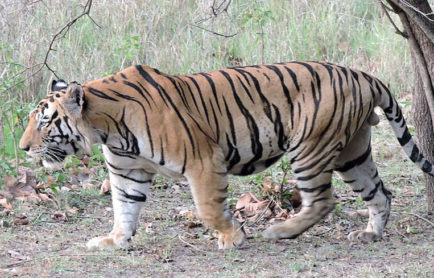How is West Bengal Supporting Wildlife Conservation?
 Last Updated: 13 May, 2019 By Tour My India
Last Updated: 13 May, 2019 By Tour My India

A series of wildlife mishaps have been taking place across the globe such as the killing of animals for tribal rituals, poaching for human possessions and animal abuse ultimately leading to their vulnerability and endangerment. But, we can sign in relief with the fact that the wildlife crisis is being handled by the concerned wildlife departments.
West Bengal has had a couple of difficult years handling the animal-human conflict as there has been a major rise in poaching in past years. But the efforts of conserving the wildlife and its habitat is constantly put on a pedestal by the concerned forest officials, state governments and various NGOs. Some of the biggest wildlife success stories that helped in conserving wildlife were of One-Horned Rhinoceros and Elephant habitat. With the animal population in West Bengal, like rhino population soaring to 255 in 2015 and the elephant population to 708 in 2014, it is noted to be the highest in West Bengal so far. When we talk about India’s national animal, the Tigers also show healthy population as witnessed through the camera trap technology installed in all wildlife reserves in West Bengal according to the blog post by All India Trinamool Congress .
In 2012, for the first time in West Bengal a census for crocodiles was performed but talking about the ugly truth of wildlife, there have also been a few downfalls during animal conservation acts. As per Mongabay, back in 2016 Environment Day, a group of locals were caught in the East Midnapore district of West Bengal with a bag full of small animals and birds and also species like monitor lizards and the Bengal’s state animal fishing cat. After interrogating, it was disclosed that it was for the local festival of Jyeshtha Amavasya or the new moon festival celebrated by the tribals in West Bengal. This is just one of the many issues that wildlife face and other existing issues that lead to wildlife endangerment are because of the growing human population in India, growth of industrialisation, climate change and habitat loss.
Also Read
The Wildlife Protected Areas in West Bengal
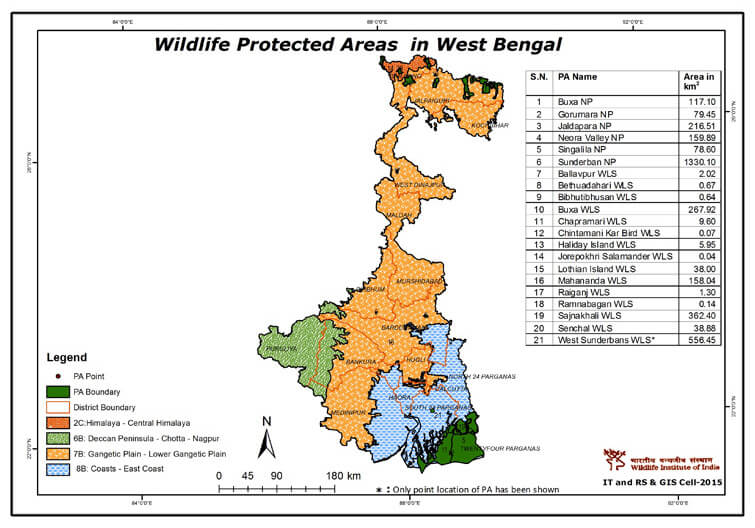
Information Source: https://goo.gl/v7yrrM
Rescue and Rehabilitation Missions of Wild Animal in West Bengal
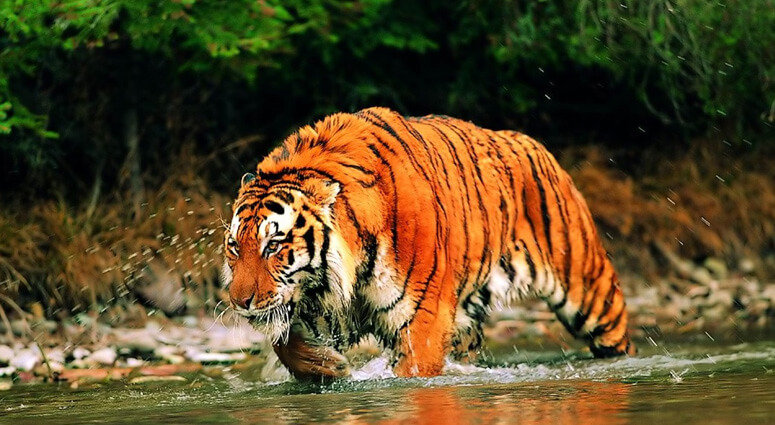
West Bengal’s wildlife administration is actively involved in missions to save animals through their rescue and rehabilitation projects. One of the projects involved in relocating the Jackals in West Bengal. Often Jackals linger around Kolkata’s Netaji Subhas Chandra Bose International Airport disturbing the operational runways and it has become a major threat to the wildlife. Through the rehabilitation project, the forest department aims to relocate the Jackal population away from the airport. This is an ongoing project that will be active until 2019 check it out here. The Wildlife Wing of Forest Directorate aims to return the stranded species in the city or other places to their original habitat. To avoid the man-animal conflict, the wildlife department in West Bengal maintains a rescue squad in various places in Kolkata to help rehabilitate the wild and also assist in animal medical treatment.
Between 2012 – 13, the animals rescued are given in the chart below: 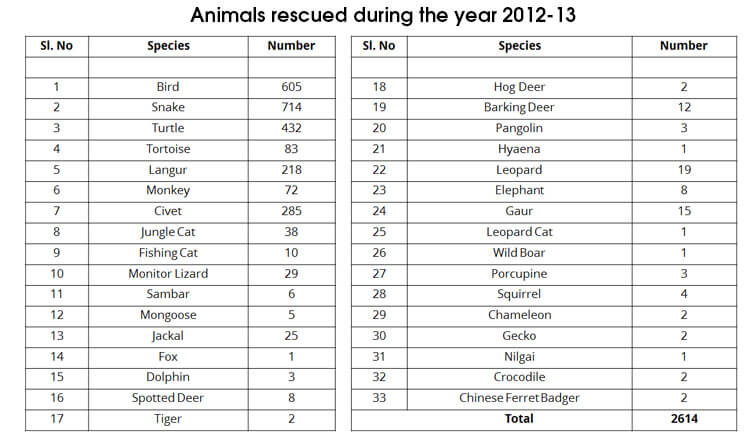
Information Source: https://goo.gl/LuzVww
Conservation Schemes and Awareness Programmes
The Wildlife Wing, Directorate of Forests also organises wildlife awareness programmes and even training classes in various educational fields. In 2012, Wildlife Quiz Contest to generate wildlife awareness were organized where 22 schools participated. To build a wildlife learning experience for children, Wildlife Wing in association with Kids for Tiger and SHER was also organised in the year 2012. A short video of tiger conservation or a call to action film made by conservation filmmaker, Shekar Dattatri titled ‘The Truth about Tigers’ was also shown, you can check out the documentary here.
The Wildlife Wing is also implementing on sponsored schemes for states wildlife and habitat conservation. Let us read about the various schemes implemented by Wildlife Wing. The State Plan Scheme oversees the annual fund received for the maintenance of forest protection, control of poaching, plantations, timber operation and conservation in wildlife reserves. National Parks and Sanctuaries Schemes come directly from the centre for the development of national parks and sanctuaries, there are used for habitat development, animal protection, developing infrastructure and eco-development.
The Government of India provides 100 percentage funds for the Project Tiger that is implemented in Buxa Tiger Reserve and Sundarban Tiger Reserve. And the central government sponsors 100 percent fund for the conservation of elephant in West Bengal. The establishment of Sundarban Biosphere Reserve and conservation of Sundarban Mangroves are also funded centrally. There is a new scheme to protect the forests called Integrated Forest Protection Scheme that is 75 percent funded by the government of India and 25 percent contribution by the government of the state.
Seizure of wildlife in West Bengal during the year 2012-13
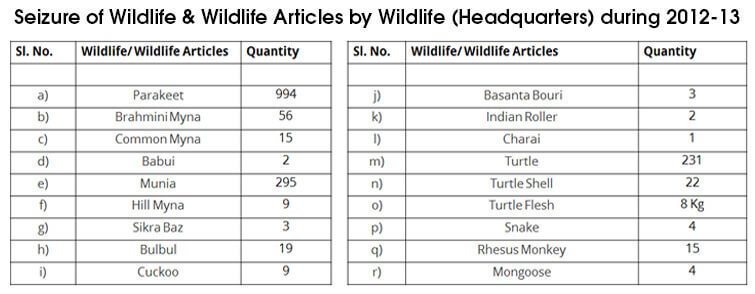
Information Source: https://goo.gl/Fz5UGc
Important aspects of the Biodiversity Conservation in West Bengal
The states entire 4064 sq.km. of forests is a protected area with 34 percent belonging to West Bengal and 4.54 percent to the geographical area. The state has one Biosphere Reserve, two Tiger Reserves, five National Parks and fifteen Wildlife Sanctuaries. Let us read how the biodiversity conservation in West Bengal is protected.
Protection of Wildlife and their Habitats: The topmost priority given to the animals is the protection of the habitat and control of poaching. Regular patrolling of the wildlife is conducted by foot, elephants back, jeeps and even on speedboats in Sundarbans. In order to protect the wildlife further, there are major steps taken to strengthen protection measures for animals like modifying the weapons of the wildlife guards, building wildlife squads, installation higher watchtower etc.
Habitat Improvement Programme: Habitat is an important element for the wildlife to sustain and the development of wetlands and water holes have been put on top priority. This program aims to maintain ground fire speaking of which, Grassland Management is one of the important activities in two of the forests, Terai and Dooars in West Bengal. In order to increase the fodder base of herbivores, indigenous grasses plantation are regularly done.
To reduce Man-Animal Conflict: Maintaining the development of corridors for large animals like Elephants are highly looked after just so no train accidents are witnessed. Many fences are build in order to avoid animals from entertaining human settlements.
Research and Monitoring: Regular monitoring of animals in the wildlife is conducted in various protected and reserved areas in West Bengal. An official census or count of tiger population in Project Tiger reserves is conducted every two years and every four years in the rest of the areas as per central government rules. Periodic monitoring of forests in West Bengal is done with various application for proper mapping using GIS technology.
The conservation of wildlife and its habitat is a serious matter worldwide and the state of West Bengal is not far behind safeguarding the species. Here are the ways that the people of the West Bengal supported Wildlife Conservation:
India alone has a wide range of biodiversity and because of its geographical distribution stretching from the snow-covered mountains to the desert, grasslands and wetlands, there are around 2,50,000 species across the country. And in West Bengal alone you can find rich flora and a wide range of fauna due to the suitable habitat that starts from the Himalayan bed to the delta region of the wildlife UNESCO Wildlife site Sundarbans. Below you can scroll through the wildlife success stories that West Bengal conquered over the years.
The conservation of the Red Pandas in Darjeeling, West Bengal

The conservation of the state animal of Sikkim, Red Panda was first started by Padmaja Naidu Himalayan Zoological Park in Darjeeling called ‘The Project Red Panda.’ This was done for the ex-situ conservation which means outside their natural habitats under Global Red Panda Management Plan in 1990. The project started its journey with just 6 Red Pandas from various zoos all over the world and based on their genotype are released in the forest under in-situ Management Programme. On 15 August 2003, two Red Pandas were released at Gairibas, a soft release centre later into the wild on 14 November same year followed by the same process in 2004. This has been a positive response from Project Red Panda.
Efforts to save the One-Horned Rhinos in West Bengal
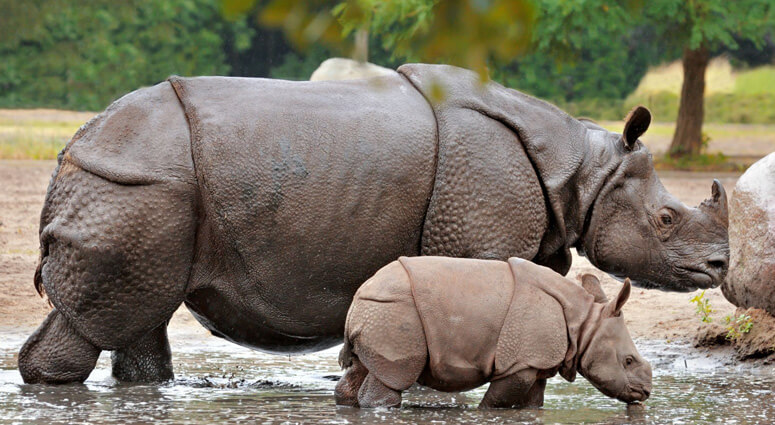
Due to the efforts by the conservationists in West Bengal, there had been no poaching news of One-Horned Rhinoceros since 2009 until 2018 when a rhino was killed and dehorned at Jaldapara National Park on February 5. According to The Hindu, in the year 2013, the rise of the rhinos in West Bengal increased to about 25 percent since 2011. The same year also witnessed a steady rise of One-Horned Rhino population in Kaziranga National Park, Assam. Besides West Bengal’s Jaldapara and Gorumara National Parks, One-Horned Rhinoceros are also located in two different reserves in Buxa Tiger Reserve, West Bengal and Patlakhawa Forest in Cooch Behar. As per the WWF India’s senior coordinator for rhino conservation, Amit Sharma, the shifting of some rhino species was done so that the animals can have enough space for connectivity and healthy gene pool. According to The Wire, it is agreed upon by many conservationists that if endangered species are scattered in different parks, it is less likely that natural calamities like floods would affect these species. Since 90 percent of the One-Horned Rhinos dwell in Kaziranga National Park, Assam making them vulnerable to catastrophes like floods or poaching. Through all the major efforts done by West Bengal conservationists, Jaldapara National Park has the second largest rhino population in India after Kaziranga National Park in Assam. 
Information Source: https://goo.gl/g75BxX
Sundarban National Park and the Ways of Conserving the Mangroves
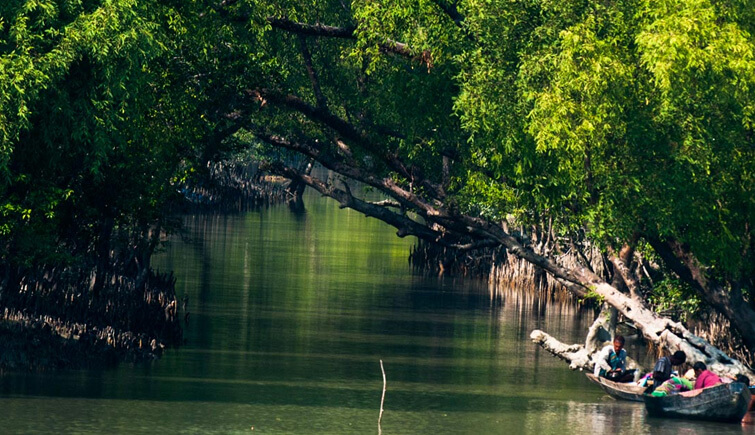 Sundarbans National Park is located on a shared boundary of India and Bangladesh and it serves as a refuge for multiple animal species like tigers, crocodiles, monitor lizard, turtles and dolphins. However, the mangroves present here acts as a natural barrier against the destructive cyclones that often occur towards the north of Bay of Bengal. And in order to conserve the mangroves, the conservationists and a couple of NGOs like Mangrove Action Project are building strategies to generate awareness and the importance of mangrove forests in protected regions. The West Bengal Tourism also organises boat cruises to various tourist interest sites and of course at the Mangrove Interpretation Centre at Sajnekhali where the visitors can explore and learn about the different species found in Sundarbans. In addition, even the people of the nearby villages like Lakshmipur are committed to protecting the mangroves. One of the villagers spoke to Nature Environment and Wildlife Society, ‘Badabon (The mangrove) saved our village many times from being washed away by these harsh river, we are committed to protecting it, whatever that may cost.
Sundarbans National Park is located on a shared boundary of India and Bangladesh and it serves as a refuge for multiple animal species like tigers, crocodiles, monitor lizard, turtles and dolphins. However, the mangroves present here acts as a natural barrier against the destructive cyclones that often occur towards the north of Bay of Bengal. And in order to conserve the mangroves, the conservationists and a couple of NGOs like Mangrove Action Project are building strategies to generate awareness and the importance of mangrove forests in protected regions. The West Bengal Tourism also organises boat cruises to various tourist interest sites and of course at the Mangrove Interpretation Centre at Sajnekhali where the visitors can explore and learn about the different species found in Sundarbans. In addition, even the people of the nearby villages like Lakshmipur are committed to protecting the mangroves. One of the villagers spoke to Nature Environment and Wildlife Society, ‘Badabon (The mangrove) saved our village many times from being washed away by these harsh river, we are committed to protecting it, whatever that may cost.
Conserving Vulture Population and Handling the Crisis Faced
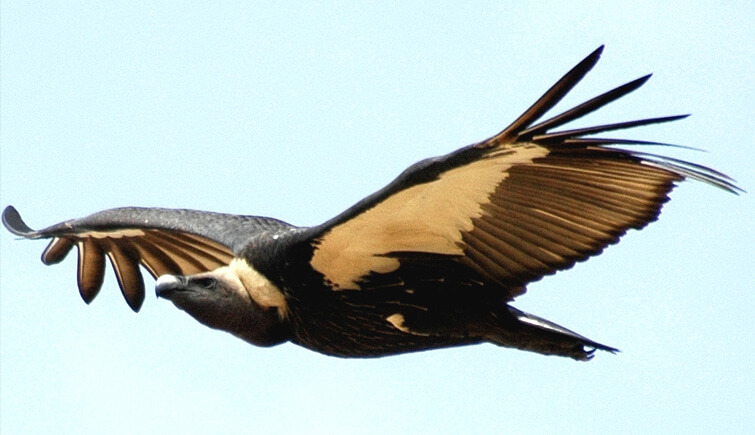
According to a wildlife website, Wild Bengal, the population of Vultures are drastically declining and in order to conserve these species The VCBC, Rajabhatkhawa, Buxa Tiger Reserve in West Bengal started its conservation in December 2005 by introducing the first vulture on March 2005. Today, there are around 16 vultures present in the complex. The reserve houses 12 Slender billed, 3 White backed and 1 Himalayan Griffon all collected from the states of Assam and West Bengal.
The Success of Conserving the Forests in West Bengal
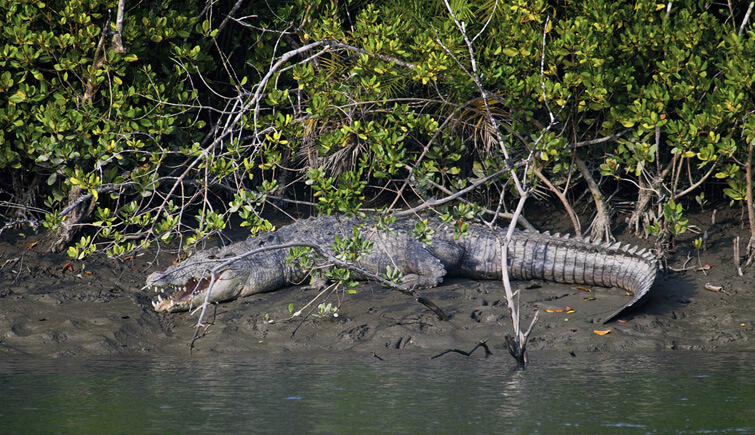
Conserving forest is perhaps far more important because it balances wildlife and even climate change we are facing. In Bengal, the forest department manages 11,879 sq km of forests and the years between 2011 and 2017 saw some notable achievements. Between these years, the forest development aforestated 72,697 ha of land and also worked on conserving the soil. Towards the end of 2016, Project Clean Ganga was also launched to conserve the Gangetic Dolphins. New wildlife enclosures were also built for the conservation of red panda and even snow leopard in Topkey Dara in Darjeeling. Emphasising on the conservation in West Bengal, two new wildlife sanctuaries were added in 2013, West Sunderbans Wildlife Sanctuary covers an area of 556 sq km for the species of Sundarbans in Parganas district and Pakhibitan Wildlife Sanctuary located in Gajoldoba, Jalpaiguri district in North Bengal covering an area of 14.09 sq km to protect exotic aquatic species and migratory birds.
These are some of the measures the people of West Bengal are marching towards and since the climate change is hampering the coastal areas of the state, the sea levels are increasing hampering the Sundarbans and the dwelling animals. The locals in the state are however fighting to save wildlife by installing certain cages as mentioned above for rehabilitation of nocturnal species that lurk in the cities. The wildlife conservation is important and it is often brought into light by educating not just in the cities but rural areas as well, since most of the hunting and animal-human conflict lingers in places near the forests. For example, the incident that occurred when the tribal people killed many endangered animals and other small species to follow the ritual, such barbaric acts must be put to a ‘STOP’ in order to give a healthier life to the endangered and vulnerable animals in West Bengal and all over the world.
 Published: 02 Apr, 2018By Tour My India
Published: 02 Apr, 2018By Tour My India
Popular Post
Category by Destinations
Travel Intel
Category by Continent
India recent post
Enquiry Form
Get Customized Travel Quotes from Tour My India







